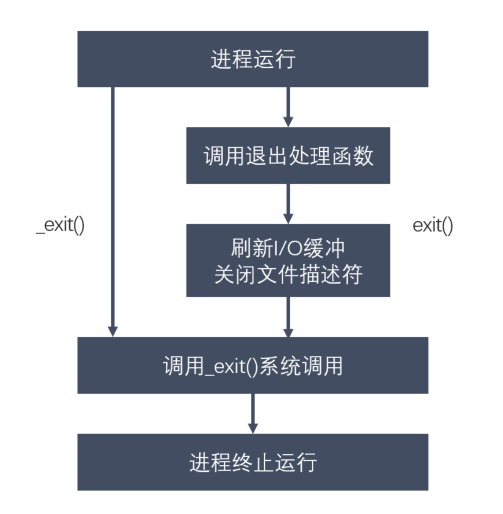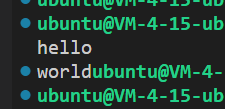Linux 多进程开发(1)
进程相关命令
1
2
3
4
5
6
7
8
9
10
11
12
13
14
15
16
17
18
19
20
21
| # 1
# man ps
# ps - report a snapshot of the current processes.
ps [-option] # aux/ajx
a: all
u:
j: job
x:
# 2
tty # 查看当前终端信息
# 3 实时查看进行信息
top [-option]
# 4 向进程发送信号
kill
kill -l # 查看所有信号
# 后台运行
[命令] &
|
进程的创建
fork函数:
1
2
3
4
5
6
7
8
9
10
11
12
13
14
15
16
17
18
19
20
21
22
23
24
25
26
27
28
29
30
31
32
33
34
35
36
37
38
39
40
41
42
43
44
45
46
47
48
49
50
51
52
53
54
55
56
57
58
59
60
61
62
63
64
65
66
67
68
69
70
71
72
73
74
75
76
77
78
79
80
81
|
#include <sys/types.h>
#include <unistd.h>
#include <stdio.h>
int main() {
int num = 10;
pid_t pid = fork();
if(pid > 0) {
printf("i am parent process, pid : %d, ppid : %d\n", getpid(), getppid());
printf("parent num : %d\n", num);
num += 10;
printf("parent num += 10 : %d\n", num);
} else if(pid == 0) {
printf("i am child process, pid : %d, ppid : %d\n", getpid(),getppid());
printf("child num : %d\n", num);
num += 100;
printf("child num += 100 : %d\n", num);
}
for(int i = 0; i < 3; i++) {
printf("i : %d , pid : %d\n", i , getpid());
sleep(1);
}
return 0;
}
|
GDB 多进程调试
gdb默认只跟踪一个进程,默认调试父进程,子进程代码直接运行。设置调试默认调试的进程:
1
| (gdb) set follow-fork-mode [parent (default) | child]
|
设置调试的模式:
1
| (gdb) set detach-on-fork [on (default) | off]
|
on:调试时其他进程继续运行;
off:调试时其他进程被 gdb 挂起。
1
2
3
4
5
6
7
8
| # 查看调试的进程
info inferiors
# 切换当前调试的进程
inferior id
# 使进程脱离 gdb 调试
detach inferiors id
|
exce 函数族
函数名称不同,功能相似的函数叫函数族。
- exec 函数族的作用是根据指定的文件名找到可执行文件,并用它来取代调用进程的内容,换句话说,就是在调用进程内部执行一个可执行文件。
- exec 函数族的函数执行成功后不会返回,因为调用进程的实体,包括代码段,数据段和堆栈等都已经被新的内容取代,只留下进程 ID 等一些表面上的信息仍保持原样。只有调用失败了,它们才会返回 -1,从原程序的调用点接着往下执行。
1
2
3
4
5
6
7
8
9
10
|
int execl(const char *path, const char *arg, ...);
int execlp(const char *file, const char *arg, ... );
int execle(const char *path, const char *arg, ...);
int execv(const char *path, char *const argv[]);
int execvp(const char *file, char *const argv[]);
int execvpe(const char *file, char *const argv[], char *const envp[]);
int execve(const char *filename, char *const argv[], char *const envp[]);
|
- l(list):参数地址列表,以空指针结尾
- v(vector) :存有各参数地址的指针数组的地址
- p(path) :按 PATH 环境变量指定的目录搜索可执行文件
- e(environment) :存有环境变量字符串地址的指针数组的地址
int execl(const char *path, const char *arg, .../* (char *) NULL */);
1
2
3
4
5
6
7
8
9
10
11
12
13
14
15
16
17
18
19
20
21
22
23
24
25
26
27
28
29
30
31
32
33
34
35
36
37
38
39
40
41
42
43
44
45
46
47
48
49
50
51
52
53
54
|
#include <unistd.h>
#include <stdio.h>
#include <sys/types.h>
int main() {
pid_t pid = fork();
if(pid > 0) {
printf("i am parent process, pid : %d\n",getpid());
sleep(1);
}else if(pid == 0) {
execl("hello","hello",NULL);
perror("execl");
printf("i am child process, pid : %d\n", getpid());
}
for(int i = 0; i < 3; i++) {
printf("i = %d, pid = %d\n", i, getpid());
}
return 0;
}
|
int execlp(const char *file, const char *arg, ... /* (char *) NULL */);
1
2
3
4
5
6
7
8
9
10
11
12
13
14
15
16
17
18
19
20
21
22
23
24
25
26
27
28
29
30
31
32
33
34
35
36
37
38
39
40
41
42
43
44
45
46
47
48
49
50
51
52
53
54
55
56
57
58
59
60
61
62
63
64
65
|
#include <unistd.h>
#include <stdio.h>
#include <sys/types.h>
int main() {
pid_t pid = fork();
if(pid > 0) {
printf("i am parent process, pid : %d\n",getpid());
sleep(1);
}else if(pid == 0) {
execlp("ps", "ps", "j", NULL);
perror("execl");
printf("i am child process, pid : %d\n", getpid());
}
for(int i = 0; i < 3; i++) {
printf("i = %d, pid = %d\n", i, getpid());
}
return 0;
}
|
进程控制
进程退出
1
2
3
4
5
6
7
|
#include <stdlib.h>
void exit(int status);
#include <unistd.h>
void _exit(int status);
|

1
2
3
4
5
6
7
8
9
10
11
12
13
14
15
16
17
18
19
20
21
22
23
|
#include <stdio.h>
#include <stdlib.h>
#include <unistd.h>
int main() {
printf("hello\n");
printf("world");
exit(0);
return 0;
}
|
exit(0) 执行的结果(会刷新缓冲区):

_exit(0) 执行的结果(不会刷新缓冲区):

孤儿进程
父进程运行结束,但子进程还在运行(未运行结束),这样的子进程就称为孤儿进程(Orphan
Process)。
每当出现一个孤儿进程的时候,内核就把孤儿进程的父进程设置为init,而 init 进程会循环地 wait() 它
的已经退出的子进程。
1
2
3
4
5
6
7
8
9
10
11
12
13
14
15
16
17
18
19
20
21
22
| #include <sys/types.h>
#include <unistd.h>
#include <stdio.h>
int main() {
pid_t pid = fork();
if(pid > 0) {
printf("i am parent process, pid : %d, ppid : %d\n", getpid(), getppid());
} else if(pid == 0) {
sleep(1);
printf("i am child process, pid : %d, ppid : %d\n", getpid(),getppid());
}
return 0;
}
|
执行结果:
子进程的文件描述符表里的012复制于父进程,所以输出到同一个终端。

僵尸进程
- 每个进程结束之后, 都会释放自己地址空间中的用户区数据,内核区的 PCB 没有办法自己释放掉,需要父进程去释放。
- 子进程终止时,父进程尚未回收,子进程残留资源(PCB)存放于内核中,变成僵尸(Zombie)进程。
- 僵尸进程不能被 kill -9 杀死,这样就会导致一个问题,如果父进程不调用 wait() 或 waitpid() 的话,那么保留的那段信息就不会释放,其进程号就会一直被占用,但是系统所能使用的进程号是有限的,如果大量的产生僵尸进程,将因为没有可用的进程号而导致系统不能产生新的进程,此即为僵尸进程的危害,应当避免。
输出:
1
2
3
4
5
6
7
8
9
| i am parent process, pid : 17195, ppid : 13038
i am child process, pid : 17196, ppid : 17195
i : 0 , pid : 17196
i : 1 , pid : 17196
i : 2 , pid : 17196
i am parent process, pid : 17195, ppid : 13038
i am parent process, pid : 17195, ppid : 13038
i am parent process, pid : 17195, ppid : 13038
...
|
新建终端使用 ps命令查看,子进程变为僵尸进程:
1
2
3
| PPID PID PGID SID TTY TPGID STAT UID TIME COMMAND
13038 17195 17195 13038 pts/0 17195 S+ 500 0:00 ./zombie
17195 17196 17195 13038 pts/0 17195 Z+ 500 0:00 [zombie] <defunct>
|
进程回收
在每个进程退出的时候,内核释放该进程所有的资源、包括打开的文件、占用的内存等。但是仍然为其保留一定的信息,这些信息主要主要指进程控制块PCB的信息(包括进程号、退出状态、运行时间等)。
父进程可以通过调用 wait 或 waitpid 得到它的退出状态同时彻底清除掉这个进程。
wait() 和 waitpid() 函数的功能一样,区别在于,wait() 函数会阻塞,waitpid() 可以设置不阻塞,
waitpid() 还可以指定等待哪个子进程结束。
注意:一次 wait 或 waitpid 调用只能清理一个子进程,清理多个子进程应使用循环。
wait() 函数
1
2
3
4
5
6
7
8
9
10
11
12
13
14
15
16
17
18
19
20
21
22
23
24
25
26
27
28
29
30
31
32
33
34
35
36
37
38
39
40
41
42
43
44
45
46
47
48
49
50
51
52
53
54
55
56
57
58
59
60
61
62
63
64
65
66
67
68
69
70
71
72
73
74
75
|
#include <sys/types.h>
#include <sys/wait.h>
#include <stdio.h>
#include <unistd.h>
#include <stdlib.h>
int main() {
pid_t pid;
for(int i = 0; i < 5; i++) {
pid = fork();
if(pid == 0) {
break;
}
}
if(pid > 0) {
while(1) {
printf("parent, pid = %d\n", getpid());
int st;
int ret = wait(&st);
if(ret == -1) {
break;
}
if(WIFEXITED(st)) {
printf("退出的状态码:%d\n", WEXITSTATUS(st));
}
if(WIFSIGNALED(st)) {
printf("被哪个信号干掉了:%d\n", WTERMSIG(st));
}
printf("child die, pid = %d\n", ret);
sleep(1);
}
} else if (pid == 0){
while(1) {
printf("child, pid = %d\n",getpid());
sleep(1);
}
exit(0);
}
return 0;
}
|
退出信息相关宏函数:
1
2
3
4
5
6
7
| WIFEXITED(status)
WEXITSTATUS(status)
WIFSIGNALED(status)
WTERMSIG(status)
WIFSTOPPED(status)
WSTOPSIG(status)
WIFCONTINUED(status)
|
waitpid() 函数
1
2
3
4
5
6
7
8
9
10
11
12
13
14
15
16
17
18
19
20
21
22
23
24
25
26
27
28
29
30
31
32
33
34
35
36
37
38
39
40
41
42
43
44
45
46
47
48
49
50
51
52
53
54
55
56
57
58
59
60
61
62
63
64
65
66
67
68
69
70
71
72
73
74
75
76
77
78
79
80
81
82
83
84
85
|
#include <sys/types.h>
#include <sys/wait.h>
#include <stdio.h>
#include <unistd.h>
#include <stdlib.h>
int main() {
pid_t pid;
for(int i = 0; i < 5; i++) {
pid = fork();
if(pid == 0) {
break;
}
}
if(pid > 0) {
while(1) {
printf("parent, pid = %d\n", getpid());
sleep(1);
int st;
int ret = waitpid(-1, &st, WNOHANG);
if(ret == -1) {
break;
} else if(ret == 0) {
continue;
} else if(ret > 0) {
if(WIFEXITED(st)) {
printf("退出的状态码:%d\n", WEXITSTATUS(st));
}
if(WIFSIGNALED(st)) {
printf("被哪个信号干掉了:%d\n", WTERMSIG(st));
}
printf("child die, pid = %d\n", ret);
}
}
} else if (pid == 0){
while(1) {
printf("child, pid = %d\n",getpid());
sleep(1);
}
exit(0);
}
return 0;
}
|



